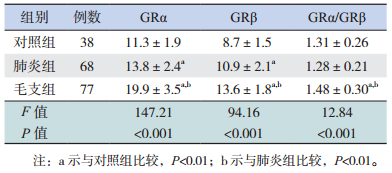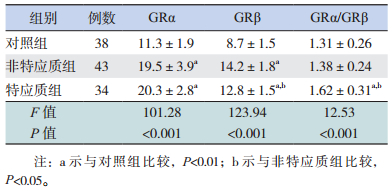毛细支气管炎(简称毛支)是婴幼儿时期最常见的喘息性疾病,是导致婴幼儿住院的常见原因[1]。由于毛支的具体发病机制尚未完全阐明,因此临床对毛支的治疗方法不一,尤其对糖皮质激素(GC)的应用存在较大争议[2-4],而GC的作用主要通过与糖皮质激素受体(GR)结合实现的[5]。特应性(atopy)体质(简称特应质)是导致毛支反复喘息甚至发展成哮喘的高危因素[6],如何对特应质的毛支患儿进行早期干预成为临床研究的热点。本研究通过检测具有特应质的毛支患儿血清GRα、GRβ水平,探讨GR表达在毛支发病机制中的作用,为临床早期合理应用GC提供依据。
1 资料与方法 1.1 研究对象2014年10月至2016年4月在我院住院的77例急性毛支患儿和68例肺炎患儿为研究对象,年龄1~14个月,均为首次发病。毛支组77例患儿中,男46例,女31例,年龄2~14个月,平均7.3±2.2个月,均符合《诸福棠实用儿科学》的诊断标准[7]。有过敏性疾病史和/或血清特异性IgE增高者诊断为特应质[8]。毛支组中符合特应质诊断标准者有34例。肺炎组68例患儿中,男44例,女24例,年龄1~12个月,平均年龄6.7±3.1个月,均为非特应质患儿。另选取同期住院的斜疝、隐睾等非感染性小儿外科术前患儿,且无特应性及过敏性疾病家族史的38例患儿作为对照组,其中男24例,女14例,年龄3~14个月,平均9.2±3.6个月。所有病例病程在5 d内,1个月内无类固醇激素或其他免疫抑制剂应用史。本课题通过了我院医学伦理委员会审批,并与患儿家属签署知情同意书。
1.2 方法患儿均于入院次日清晨8点抽取静脉血2 mL,静置1 h,2 000 r/min离心10 min,提取血清后置-70℃冰箱保存待检。采用ELISA法检测血清中总IgE、GR-α和GR-β水平。所用试剂购自浙江杭州辉图生物科技有限公司,严格按试剂盒说明书操作。
1.3 统计学分析采用SPSS 17.0统计软件进行统计学处理与分析。计量资料用均数±标准差(x±s)表示,多个样本均数的比较采用单因素方差分析,组间两两比较采用SNK-q检验,P < 0.05为差异有统计学意义。
2 结果 2.1 对照组、肺炎组和毛支组血清GRα及GRβ水平的比较肺炎组和毛支组血清GRα、GRβ水平高于对照组(P < 0.01);毛支组血清GRα、GRβ水平高于肺炎组(P < 0.01)。毛支组GRα/GRβ比值高于肺炎组和对照组(P < 0.01),肺炎组和对照组两组间比较差异无统计学意义(P > 0.05)。见表 1。
| 表 1 对照组、肺炎组和毛支组血清GRα及GRβ水平的比较(x±s,ng/mL) |
2.2 特应质对毛支患儿血清GRα及GRβ水平的影响
毛支患儿中,特应质和非特应质亚组血清GRα、GRβ水平与对照组比较显著升高(P < 0.01);特应质和非特应质亚组血清GRα水平比较差异无统计学意义(P > 0.05),但特应质亚组血清GRβ水平低于非特应质亚组(P < 0.05)。特应质亚组GRα/GRβ比值高于非特应质亚组和对照组(P < 0.01),而非特应质亚组和对照组间比较差异无统计学意义(P > 0.05)。见表 2。
| 表 2 特应质对毛支患儿血清GRα及GRβ水平的影响(x±s,ng/mL) |
3 讨论
毛支是婴幼儿时期最常见的喘息性疾病,特应质是导致毛支患儿反复喘息的一个重要原因,也是毛支发展成为哮喘的一个重要的预测指标[9],因此,对具有特应质的毛支患儿进行积极治疗和早期干预显得尤为重要。由于目前对毛支的发病机制尚未完全明确,治疗方法不一,尤其对GC的应用存在较大的争议[10-11]。GC主要通过与GR结合并在GR的介导下发挥生物学效应,目前发现的GR包括GRα和GRβ两种亚型。国内外的研究表明,GRβ可能是一种潜在的内源性GC效应的拮抗因子,GRβ的表达增高可直接或间接与GRα结合,降低机体对GC的反应性[12]。因此,目前认为,GR亚型表达差异可能是导致疾病对GC不同反应的机制之一,故测定毛支患儿GR水平的变化有助于指导GC治疗。既往对细菌和病毒感染性疾病中GC抵抗的研究非常少见[13]。本研究发现,与对照组比较,毛支组和肺炎组中血清GRα、GRβ水平均明显升高,毛支组与肺炎组比较,血清GRα、GRβ水平均显著增加,说明在毛支患儿中GR水平表达增强,这与文献报道一致[14]。而GRβ的表达增高可拮抗GC与GRα的结合,因此,两者表达比例的变化是机体对GC产生反应性的关键因素。本研究发现,毛支组GRα/GRβ比值较对照组和肺炎组明显升高,而后两者则无显著性差异,推测可能与本研究选择的病例当中特应质患儿比例较高有关,同时说明在毛支患儿中可以选择性使用GC,尤其是针对GRα/GRβ比值增高的患儿,这为临床合理应用GC治疗毛支提供了佐证[15]。
特应质是毛支发展成为哮喘的一个重要原因。本研究进一步测定特应质和非特应质毛支患儿的血清GR水平并进行比较,发现与对照组比较,毛支特应质和非特应质亚组中血清GRα、GRβ水平均明显升高;非特应质亚组GRβ水平与特应质亚组比较表达明显增强;毛支特应质亚组GRα/GRβ比值较对照组和非特应质组明显升高,而后两者则无显著性差异,说明在毛支特应质和非特应质亚组患儿中均存在着GR表达的增强,但是,在毛支非特应质亚组中由于较高的GRβ水平表达,引起GRα/GRβ之间的平衡发生漂移,这种改变将导致GC敏感或GC抵抗的发生,即GRα/GRβ比值增大使GC敏感度增加,GRα/GRβ比值减小使GC抵抗增强[16]。本研究中特应质毛支患儿表现为GRα/GRβ比值的增加,而非特应质患儿GRα/GRβ比值则无明显增加,提示特应质毛支患儿对GC有较高的敏感性,而非特应质毛支患儿则可能存在较高的GC抵抗,说明临床上早期应用GC治疗特应质毛支患儿可能较为有效。
综上所述,毛支患儿血清GRα、GRβ表达水平增强,其中特应质患儿表现为GRα/GRβ比值的增加。GRα/GRβ比值增加使GC敏感度增加,这为特应质毛支患儿临床应用GC提供了理论依据。由于GC在机体中发挥作用的机制较为复杂,本研究测定的是血清GR水平,而GR与GC结合后,必须转移到细胞核内才能发挥作用[17],因此,深入研究GR的核内转移有助于进一步了解GC的作用机制。
| [1] | McNaughten B, Bourke TW. Optimising the management of bronchiolitis in infants[J]. Practitioner, 2015, 259 (1784): 13–15. |
| [2] | Ochoa Sangrador C, González de Dios J, Research Group of the aBREVIADo Project. Overuse of bronchodilators and steroids in bronchiolitis of different severity:bronchiolitisstudy of variability, appropriateness, and adequacy[J]. Allergol Immunopathol (Madr), 2014, 42 (4): 307–315. DOI:10.1016/j.aller.2013.02.010 |
| [3] | Tagarro A, Pérez L, Quintero VM, et al. Dexamethasone does not reduce length of hospitalization or recurrent wheezing 1 year after early bronchiolitis[J]. Minerva Pediatr, 2014, 66 (2): 131–140. |
| [4] | Plint AC, Grenon R, Klassen TP, et al. Bronchodilator and steroid use for the management of bronchiolitis in Canadian pediatric emergency departments[J]. CJEM, 2015, 17 (1): 46–53. DOI:10.2310/8000.2013.131325 |
| [5] | 王德全, 王玉国, 刘保国, 等. 糖皮质激素受体基因多态性与自身免疫性疾病相关性研究进展[J]. 河北医药, 2015, 37 (12): 1866–1868. |
| [6] | 姚臻, 莫炜明, 赵善和, 等. 小剂量糖皮质激素吸入干预毛细支气管炎后反复喘息和哮喘发病率的临床观察[J]. 延边医学, 2015, 4 (10): 222–225. |
| [7] | 张梓荆, 申昆玲.毛细支气管炎[M].胡亚美, 江载芳.诸福棠实用儿科学.第7版.北京:人民卫生出版社, 2002:1199-1201. |
| [8] | Relić T, Ilić N, Kostić G, et al. Respiratory syncytial virus infection and bronchial hyperreactivity in children up to two years of age in correlation with atopy[J]. Vojnosanit Pregl, 2016, 73 (1): 59–65. DOI:10.2298/VSP140930030R |
| [9] | Wang W, Huang KW, Wu BM, et al. Correlation of eosinophil counts in induced sputum and fractional concentration of exhaled nitric oxide and lung functions in patients with mild to moderate asthma[J]. Chin Med J (Engl), 2012, 125 (17): 3157–3160. |
| [10] | Webster Marketon JI, Corry J, Teng MN. The respiratory syncytial virus (RSV) nonstructural proteins mediate RSV suppression of glucocorticoid receptor transactivation[J]. Virology, 2014, 449 : 62–69. DOI:10.1016/j.virol.2013.11.014 |
| [11] | Fernandes RM, Hartling L. Glucocorticoids for acute viral bronchiolitis in infants and young children[J]. JAMA, 2014, 311 (1): 87–88. DOI:10.1001/jama.2013.284921 |
| [12] | Barnes PJ. Corticosteroid resistance in patients with asthma and chronic obstructive pulmonary disease[J]. J Allergy Clin Immunol, 2013, 131 (3): 636–645. DOI:10.1016/j.jaci.2012.12.1564 |
| [13] | Webster JI, Sternberg EM. Role of the hypothalamic-pituitaryadrenal axis, glucocorticoids and glucocorticoid receptors in toxic sequelae of exposure to bacterial and viral products[J]. J Endocrinol, 2004, 181 (2): 207–221. DOI:10.1677/joe.0.1810207 |
| [14] | Diaz PV, Pinto RA, Mamani R, et al. Increased expression of the glucocorticoid receptor β in infants with RSV bronchiolitis[J]. Pediatrics, 2012, 130 (4): 804–811. DOI:10.1542/peds.2012-0160 |
| [15] | 兰伟平, 王婧, 代传林, 等. 丙酸氟替卡松气雾剂或布地奈德混悬液干预对毛细支气管炎反复喘息的疗效观察[J]. 中国当代儿科杂志, 2016, 18 (4): 316–319. |
| [16] | Lewis-Tuffin LJ, Cidlowski JA. The physiology of human glucocorticoid receptor beta (hGR beta) and glucocorticoid resistance[J]. Ann N Y Acad Sci, 2006, 1069 : 1–9. DOI:10.1196/annals.1351.001 |
| [17] | 方丽萍, 辛晓峰. 激素抵抗型哮喘发病机制的研究进展[J]. 医学研究生学报, 2013, 26 (10): 1113–1116. |
 2017, Vol. 19
2017, Vol. 19




